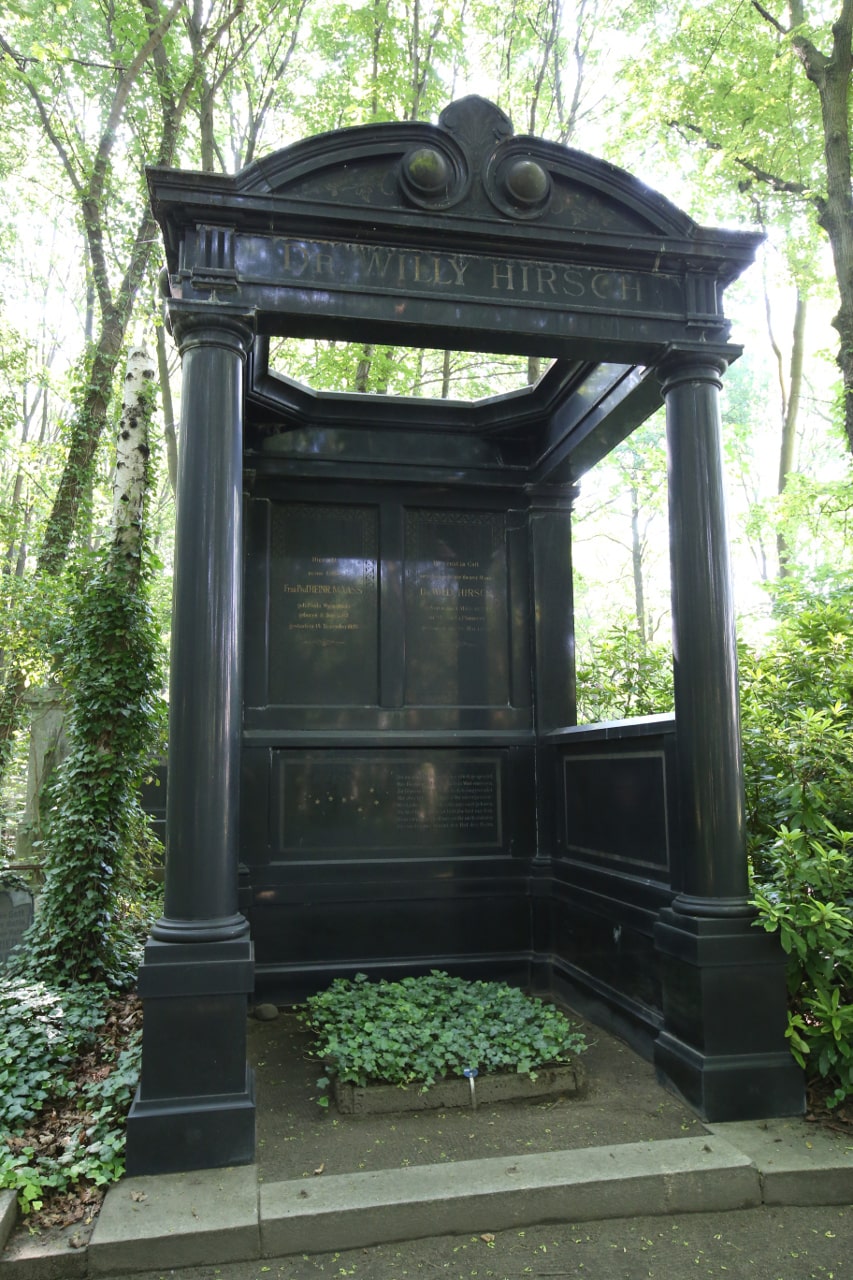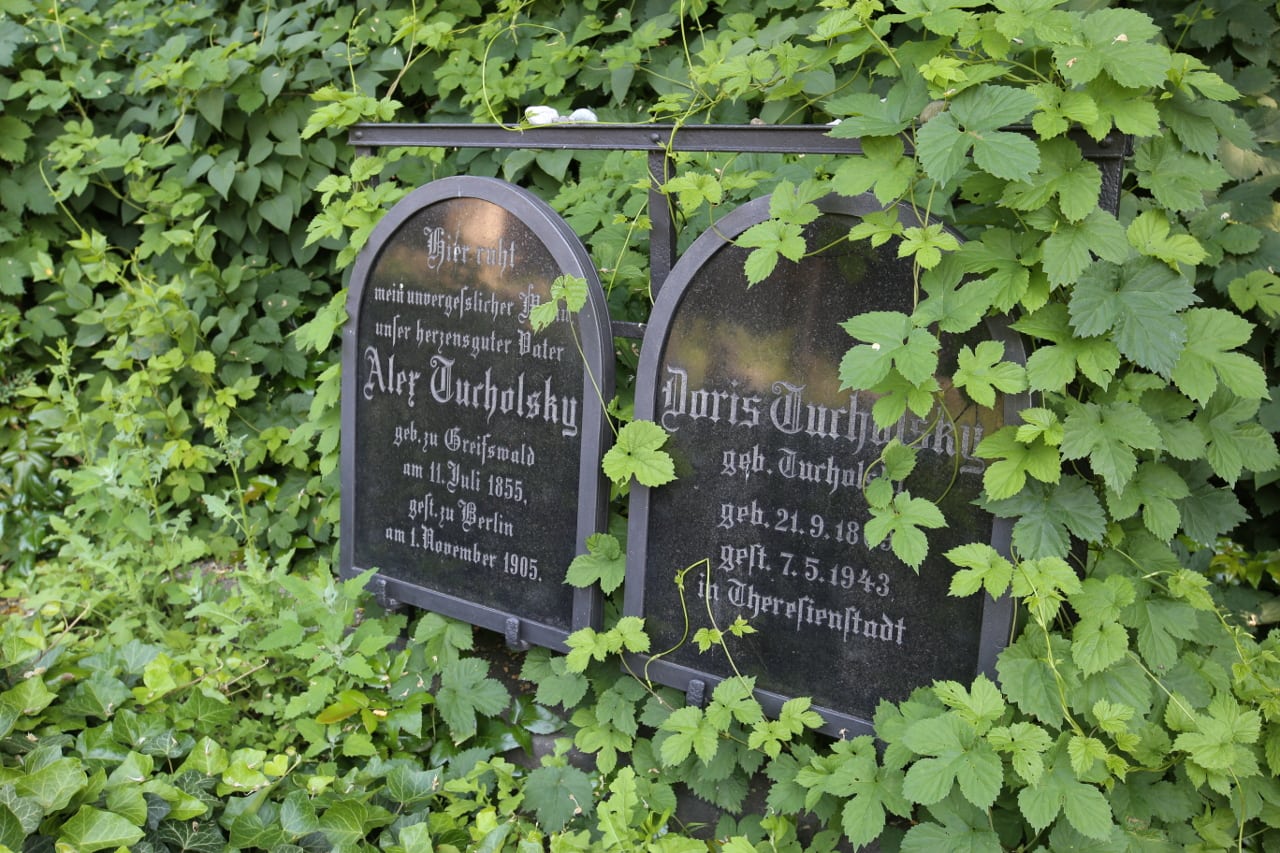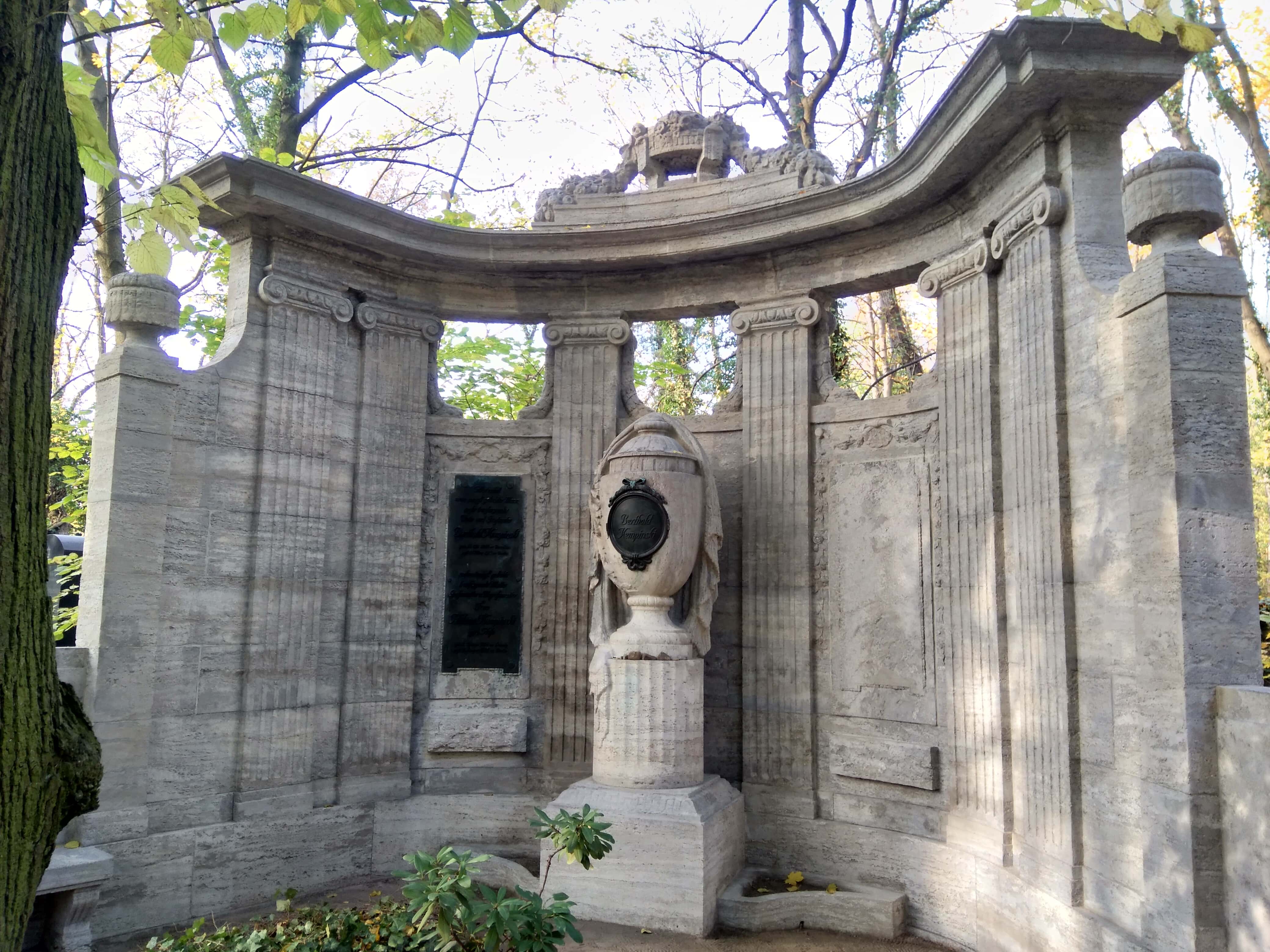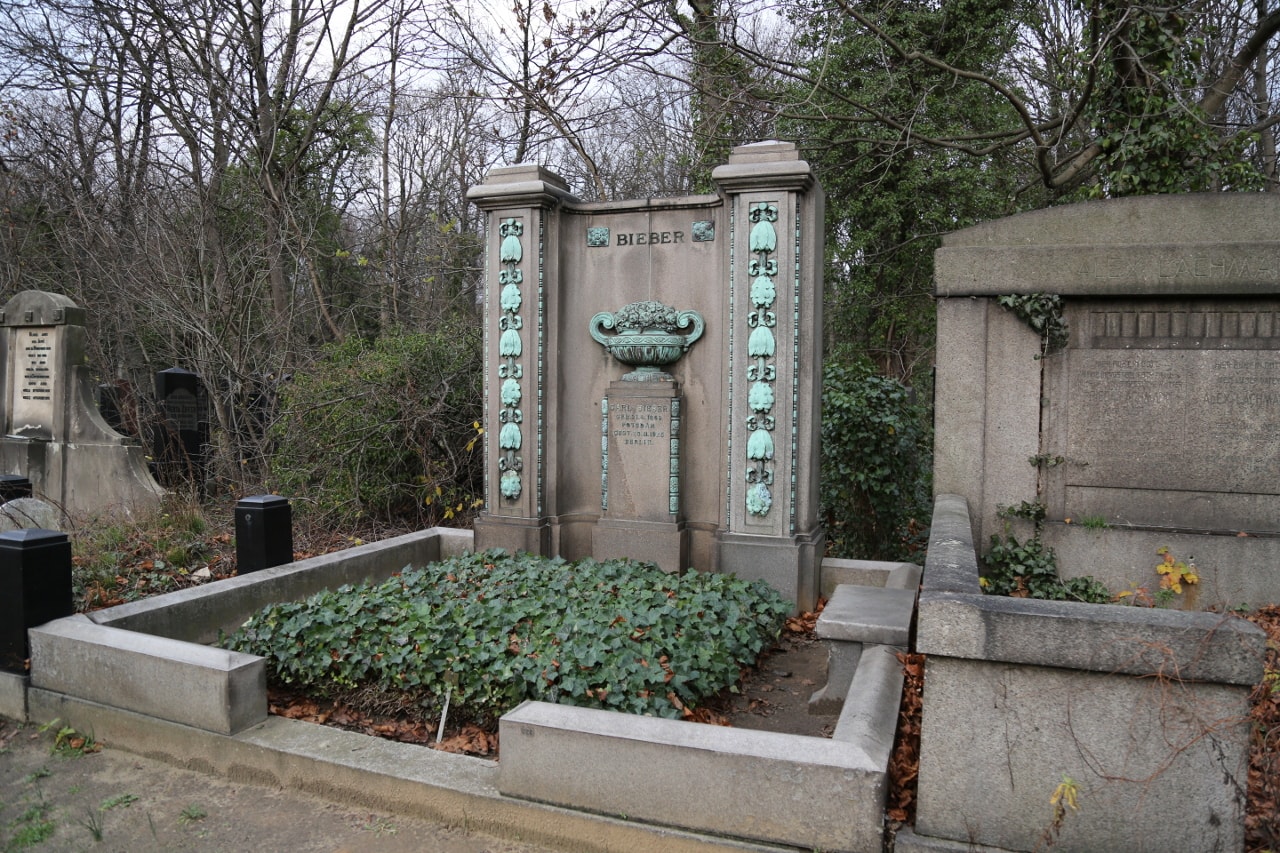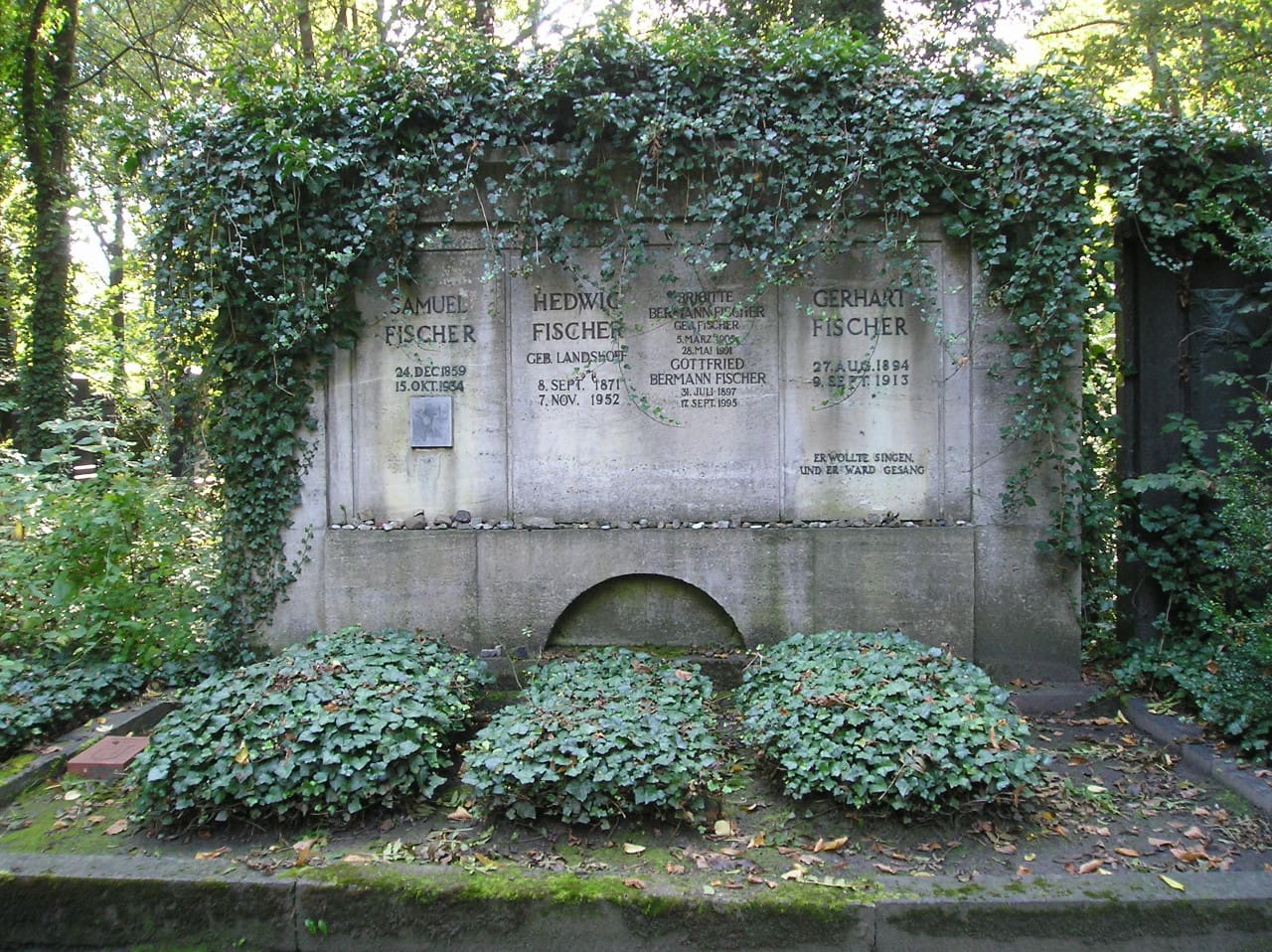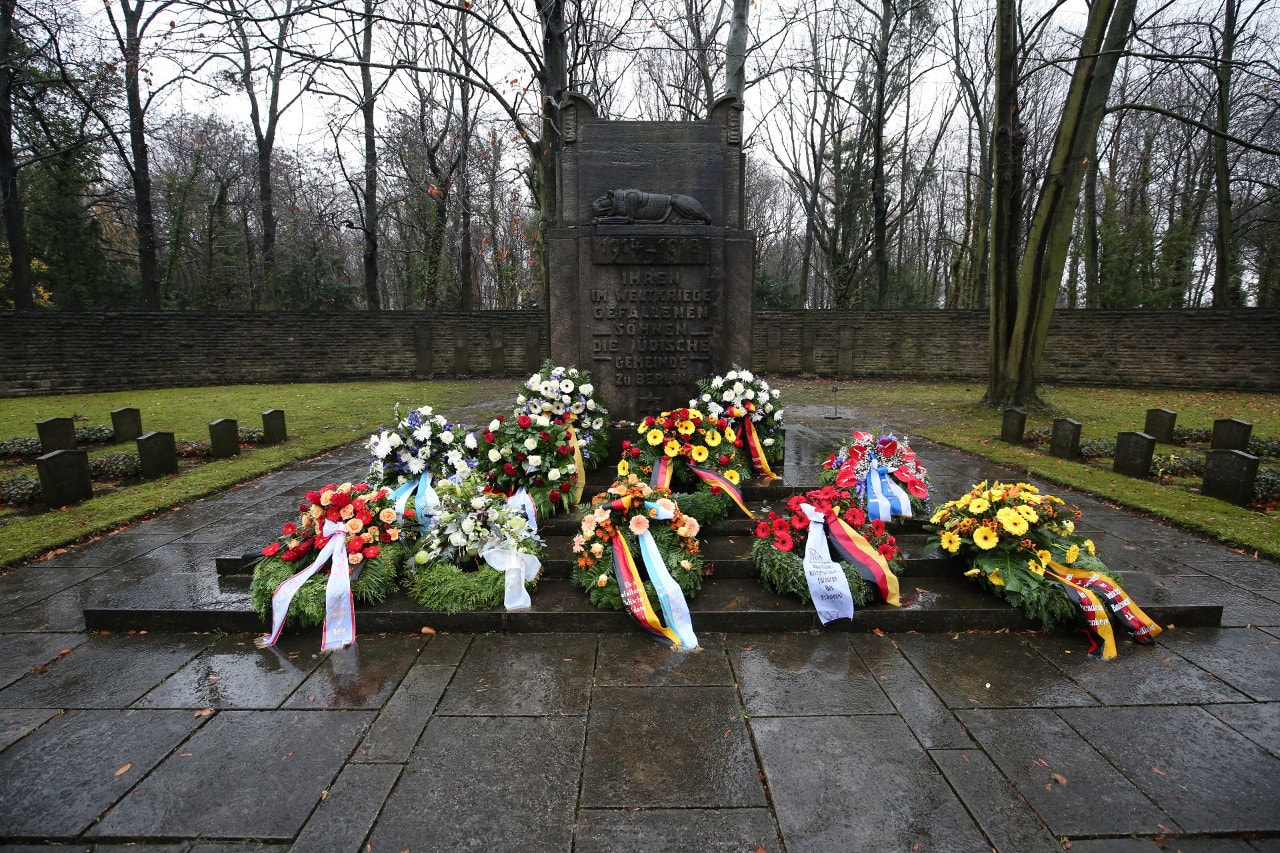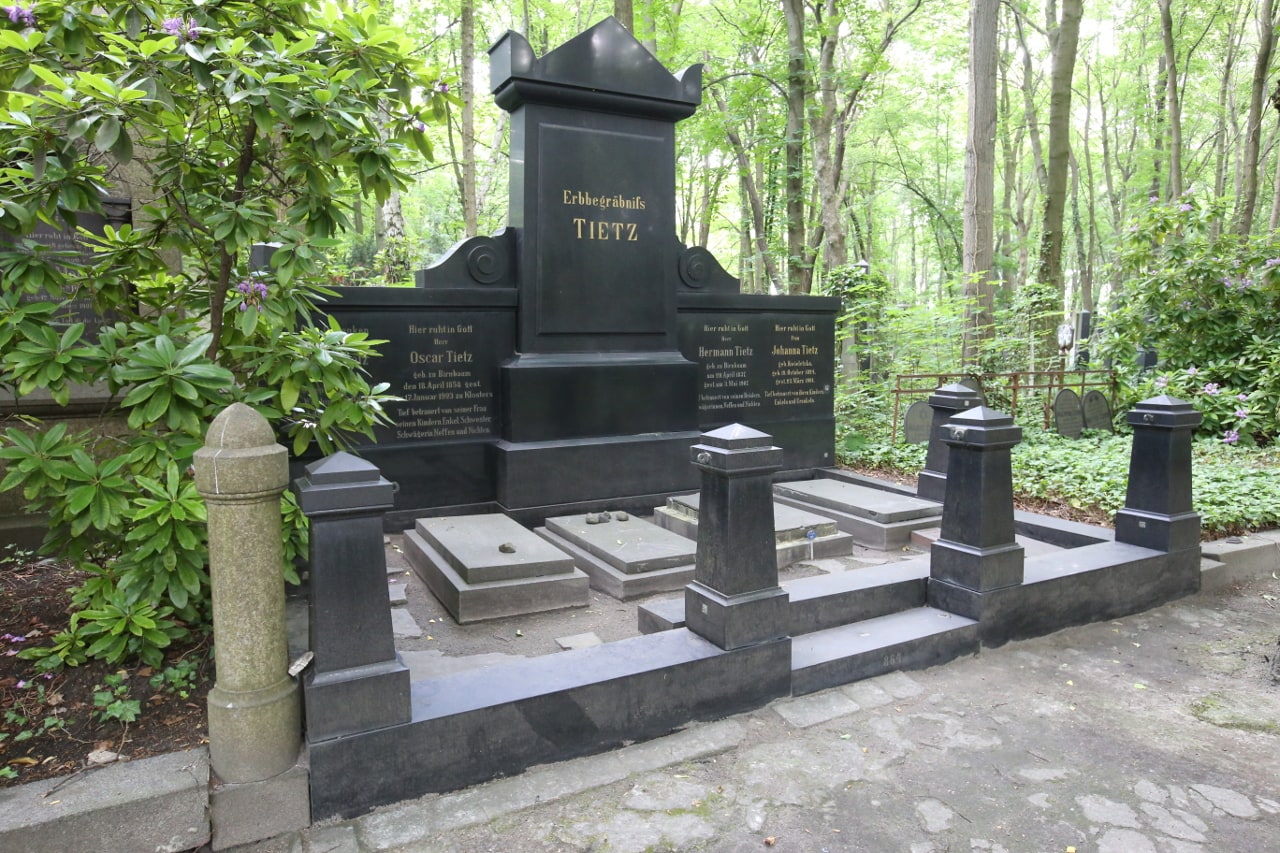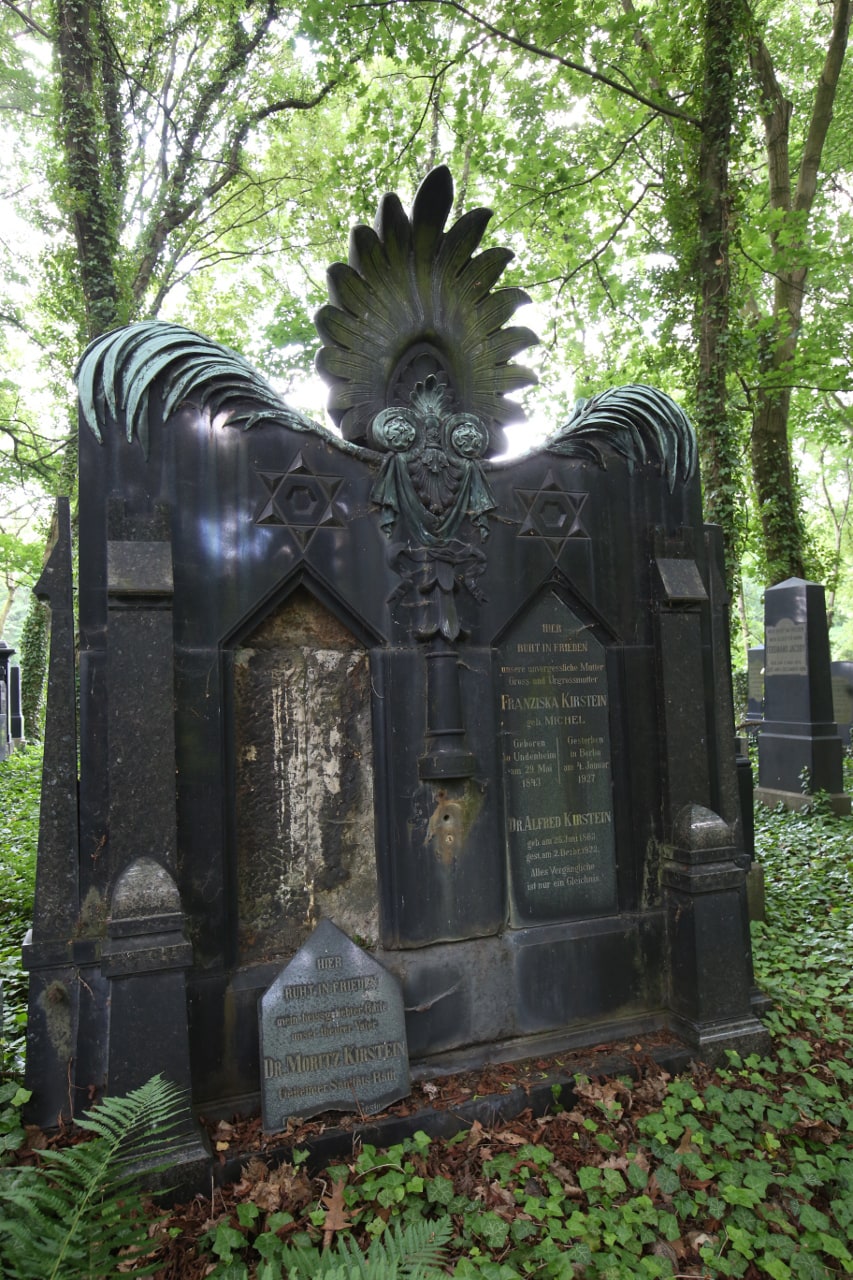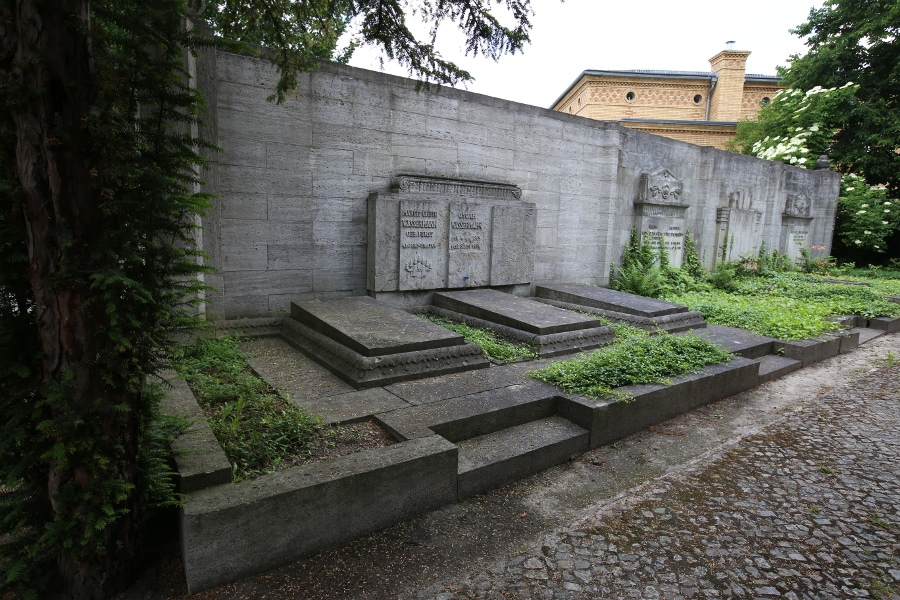
It took a long time before the Memorial to the Victims of National Socialism could finally be erected. As early as March 22, 1947, the Jewish Community of Berlin had submitted the first application to the municipal authorities of Greater Berlin. However, the application was deferred on the grounds that there was a shortage of building materials. Thereupon the Jewish Community of Berlin offered stones from the wrecked synagogue in the Fasanenstrasse. Finally, on October 11, 1953, a stone was unveiled, which is still the Memorial today: it is located in the roundel in the entrance area of the cemetery. Arranged in a circle are memorial plaques bearing 20 names of the principal concentration camps and death camps carved in stone: Auschwitz, Theresienstadt, Neuengamme, Sachsenhausen, Dachau, Gross-Rosen, Lublin-Maidanek, Stutthoff, Flossenbürg, Mauthausen, Treblinka, Bergen-Belsen, Natzweiler, Gusen, Ebensee, Plötzensee, Brandenburg, Esterwegen, Ravensbrück, Buchenwald. An urn containing the ashes of Jews murdered in Auschwitz was placed in the ground in front of the memorial stone on January 27, 1992. The urn had been solemnly handed over in a ceremony to the former Auschwitz prisoner and then head cantor of the Jewish Community of Berlin, Estrongo Nachama, the Auschwitz prisoner Martin Friedländer, and the then Jewish Cemetery inspector Manfred Alpern at the Jagdschloss Glienicke palace. This horrific legacy was brought to Berlin by the then director of the Auschwitz-Birkenau Museum, Jerzy Wróblewski.
It took a long time before the Memorial to the Victims of National Socialism could finally be erected. As early as March 22, 1947, the Jewish Community of Berlin had submitted the first application to the municipal authorities of Greater Berlin. However, the application was deferred on the grounds that there was a shortage of building materials. Thereupon the Jewish Community of Berlin offered stones from the wrecked synagogue in the Fasanenstrasse. Finally, on October 11, 1953, a stone was unveiled, which is still the Memorial today: it is located in the roundel in the entrance area of the cemetery. Arranged in a circle are memorial plaques bearing 20 names of the principal concentration camps and death camps carved in stone: Auschwitz, Theresienstadt, Neuengamme, Sachsenhausen, Dachau, Gross-Rosen, Lublin-Maidanek, Stutthoff, Flossenbürg, Mauthausen, Treblinka, Bergen-Belsen, Natzweiler, Gusen, Ebensee, Plötzensee, Brandenburg, Esterwegen, Ravensbrück, Buchenwald. An urn containing the ashes of Jews murdered in Auschwitz was placed in the ground in front of the memorial stone on January 27, 1992. The urn had been solemnly handed over in a ceremony to the former Auschwitz prisoner and then head cantor of the Jewish Community of Berlin, Estrongo Nachama, the Auschwitz prisoner Martin Friedländer, and the then Jewish Cemetery inspector Manfred Alpern at the Jagdschloss Glienicke palace. This horrific legacy was brought to Berlin by the then director of the Auschwitz-Birkenau Museum, Jerzy Wróblewski.
Louis Lewandowski was a cantor, composer, and choral director. He was the first Jew to be accepted as a student in the music department of the Berlin Academy of Arts. Lewandowski rendered enduring services to the musical design of modern Jewish worship. From 1840, he was the conductor of the newly established four-part choir of the Old Synagogue in Heidereutergasse. On the 25th anniversary of serving as a choral director, Lewandowski was appointed Royal Director of Music in 1865. In 1866, he assumed the post of choral director at the New Synagogue in Oranienburger Strasse. Louis Lewandowski and his wife Helene rest in a privileged place in the Row of Honour. On their gravestone in the area of the pedestal, the lyre framed by palm fronds and laurel branches make reference to Lewandowski’s musical activities. His compositions were popular far beyond the Jewish communities and are still performed today. Since 2011, the Louis Lewandowski Festival has been held in Berlin — an international festival of synagogue music dedicated to this German-Jewish composer and conductor.
Martin Riesenburger was a preacher and pastor at the retirement home of the Jewish Community in Grosse Hamburger Strasse as of 1933. In 1943, the Jewish Community in Berlin was disbanded and Riesenburger was transferred to Weissensee. In addition to the Jewish Hospital in Wedding, the Jewish Cemetery in Weissensee was in constant operation during the Nazi era. Martin Riesenburger worked there as a preacher and pastor after June 10, 1943. In his memoirs, he reports that “every Jew who died before the hour of liberation in 1945 was buried exactly according to the rites of our Jewish religion. The terrible and mentally burdensome work of the few Jewish people labouring in the local cemetery must never be forgotten.” After the end of Nazi rule, the first public Jewish service after the liberation took place in the cemetery on May 11, 1945. Martin Riesenburger now devoted his energy to the rebuilding of the Jewish Community of Berlin. However, the unity of the community did not last; in 1953 it was divided into an East and a West Berlin community, until in January 1991 the two communities were reunited. In 1961, the Association of Jewish Communities in East Germany had elected Martin Riesenburger State Rabbi, a post he held until his death in 1965. In September 1999, his widow Klara Riesenburger (1901–1999) passed away; she was buried next to him.
Theodor Wolff was an internationally respected journalist and writer. To begin with, he was the Paris correspondent of the Berliner Tageblatt, a daily newspaper founded by Rudolf Mosse in 1872, and was its editor-in-chief from 1906 to 1933. The owner of the Tageblatt, Hans Lachmann-Mosse, dismissed Wolff in March 1933 under pressure from the Nazis. Wolff’s books were burned. Wolff and his wife fled to Nice via Switzerland. In 1937, they were expatriated from the German Reich. Wolff was arrested on May 23, 1943 in Nice. First imprisoned in Marseille and in the Drancy internment camp, Wolff was soon deported to Sachsenhausen concentration camp. Terminally ill, he arrived at the Jewish Hospital in Berlin on September 20, 1943, where he died shortly afterwards. His grave with its plain granite stele was laid out in the first burial Field A by extending Row 10 to the path, and is a Grave of Honour of the State of Berlin. Since 1973, the Federal Association of German Newspaper Publishers has commemorated him with the Theodor Wolff Award, which was endowed in 1961. (Grave of Honour of the State of Berlin)
The writer Angelika Schrobsdorff learned when she was only eleven years old, during a supposed vacation trip to Bulgaria, that she would remain in exile there with her mother and sister and that her mother Else is Jewish. In 1947, Angelika Schrobsdorff returned to Germany, and in the late 1950s she began to write. In 1961, her debut novel Die Herren (The Gentlemen/The Masters) was published. “She tells what she has experienced, and she tells it with distance and tender irony,” wrote her writer friend Simone de Beauvoir in the preface to Schrobsdorff’s collection of stories Die Reise nach Sofia (The Journey to Sofia) (1983). In the early 1960s, Angelika Schrobsdorff went to Jerusalem for the first time, where she visited a friend of her mother. There, in 1971, she met filmmaker Claude Lanzmann, who was immediately fascinated by her. The couple married in Jerusalem in 1974. Unable to persuade her husband to live there, she moved with him to Paris. After the breakdown of her marriage and years of commuting between Germany, France, and Israel, she relocated to Jerusalem in 1983. However, as the years went by, she became increasingly critical of the political situation in Israel, so she left the country in 2006 and returned to Berlin, the place where she had spent her childhood.
The writer Stefan Heym, who was born Helmut Flieg, adopted his new name in 1933 after fleeing from Berlin to Prague. In 1935, a grant from the Jewish Student Union enabled him to move to the United States where he continued his literary studies in Chicago. As a sergeant in the U.S. Army, he set foot on German soil again in 1945. In 1953 he returned to Berlin for good.
During the sluggish process of de-Stalinisation after 1956, Heym developed an increasingly critical attitude toward the policies of the Socialist Unity Party of East Germany (SED) and was even temporarily banned from publishing in 1965. A rapprochement with the party ended in 1976 when Heym signed the petition protesting against the expatriation of Wolf Biermann. In the 1980s, he supported the East German civil rights movement. After the political changes of 1989 when the Berlin Wall fell, he worked in German politics as an independent member of the Bundestag, and from 1994 to October 1995 he served as the senior president of the German Bundestag. Stefan Heym died of heart failure in Israel on December 16, 2001, at the age of 88. The reason for his trip to Israel was to attend a congress on his favourite poet Heinrich Heine. The limestone gravestone, which tapers slightly towards the bottom, bears Heym’s signature, his name.
A resistance group consisting of young people formed around Herbert Baum and his wife Marianne in the years 1939 to 1942. Most of the members were of Jewish origin, and almost half of the group were young women. In the beginning, the focus was on cultural work; only later did they all pursue just one goal: to overthrow Hitler and his regime. They organised an arson attack on the anti-Communist and anti-Semitic propaganda exhibition prepared by the leadership of the Nazi Party titled The Soviet Paradise at the Berlin Lustgarten on May 8, 1942. Herbert and Marianne Baum as well as other members of the group were betrayed, arrested, and later murdered. The cemetery’s archive records state that Herbert Baum was hanged in the police prison, Am Alexanderplatz 1, on June 11, 1942. His body was buried in the Marzahn Park Cemetery and was only moved to Weissensee on September 11, 1949. In 1951, Lothringenstrasse that leads to the cemetery was renamed Herbert-Baum-Strasse. (Grave of Honour of the State of Berlin)
The philosopher Hermann Cohen began his studies at the Jewish Theological Seminary in Breslau. From 1861 he studied Jewish theology, classical studies, and philosophy at Berlin University. In 1870, Cohen published a contribution to the simmering academic controversy over the interpretation of Immanuel Kant’s philosophy. And in his book Kant’s Theory of Experience, he proposed a new interpretation of Kant and established himself, along with the philosopher Paul Natorp (1854–1945), as one of the main representatives of Marburg Neo-Kantianism. From 1876, Cohen was a professor of philosophy at the University of Marburg. In 1878, he married Martha Lewandowski, the daughter of the composer Louis Lewandowski. A year after his retirement in 1912, Cohen moved to Berlin, where he taught at the Hochschule für die Wissenschaft des Judentums (Higher Institute for Jewish Studies). Published posthumously, his most important work on the philosophy of religion, Die Religion der Vernunft aus den Quellen des Judentums, translated as Religion of Reason: Out of the Sources of Judaism, was published in 1919.
The philosopher’s surname, Cohen, refers to his descent from Levitical priests or kohanim. The kohanim performed their service in the Temple at the altar. They are considered direct descendants of Aaron, Moses’ brother. On the tombs of kohanim descendants, as on Hermann Cohen’s tomb, there are often two hands joined forming a diamond under a crown as a symbol of descent. The grave mark, carved from shell limestone, cites a form of sarcophagus tomb known since classical antiquity.
Lesser Ury was one of the most important Jewish painters of the 20th century in Berlin. After the death of his father, his mother wanted him to serve an apprenticeship as a tailor. Ury, however, enrolled for one year at the Art Academy in Düsseldorf, after which he went on to Brussels and Paris. The pictures he painted at this time were influenced by the French Impressionists. From 1885, he lived in Berlin and was in close contact with Max Liebermann. With his paintings, he was one of the pioneers of German Impressionism. Ury painted religious motifs, still lifes, landscapes, and cityscapes. More than half of Ury’s paintings were burned by the Nazis. (Grave of Honour of the State of Berlin)
On the gravestone of Natalie Baeck, née Hamburger, an inscription commemorates her husband, the rabbi and religious philosopher Leo Baeck (*1873 Lissa, Posen, †1956 London), who is buried in London. Leo Baeck completed his rabbinical studies in Berlin in 1895 at the liberal Higher Institute for Jewish Studies. After positions as rabbi in Oppeln and Düsseldorf, Leo Baeck was appointed rabbi in Berlin in 1912 and worked in the newly built synagogue in Fasanenstrasse. He also became a lecturer at the Higher Institute for Jewish Studies. During the First World War he was a military rabbi. After the end of the war, Baeck was increasingly assigned representative duties in the Jewish Community of Berlin as well as offices in politics and Jewish organisations. As president of the Reich Representation of German Jews, founded in 1933, he was the spokesman for the Jewish Community in their darkest times. Despite several opportunities to emigrate, Baeck remained with his community. In 1943, he was deported to the Theresienstadt concentration camp. Baeck survives and moved to London after the liberation in 1945. An honoured representative of liberal Judaism, he became a professor of religious history at Hebrew Union College in Cincinnati in 1948. Leo Baeck died in London in 1956 and was buried in Hoop Lane Jewish Cemetery. The Leo Baeck Institute (LBI), founded in 1955 with branches in New York, London, and Jerusalem, is named after him. Since 1957, the Central Council of Jews in Germany has awarded the annual Leo Baeck Prize, which was established in 1956.
Ferdinand Strassmann was from a large family, one of four brothers who all became respected physicians. After studying medicine, Ferdinand Strassmann settled in Berlin in 1863 as a general practitioner. In addition to his medical work, he became increasingly involved in local politics and had to give up his medical practice as a result. From 1884, he was a citizen deputy in the school deputation of the Berlin City Council, and in 1889 he was elected unsalaried City Councillor for Medicine. As the only physician in the municipal administration, he supported the construction of new hospitals, mental hospitals, and convalescent homes, as well as the expansion of the municipal disinfection and sanitary system. In recognition of his 30 years of service to public health, he was given the honorary citizenship of Berlin in December 1915. (Grave of Honour of the State of Berlin)
Gustav Frenkel, son of the banker Samuel Frenkel, who was active in the family business, died in March 1882 when he was only 35. His family approached the Architects’ Association of Berlin with a request that one of their monthly competitions should be announced to the association’s members as a design competition for a large hereditary grave. The competition was won in January 1883 by the young architect Alfred Messel (1853–1909). Frenkel’s memorial was his first architectural project to be realised. Messel later achieved fame above all for his spectacular designs for the Wertheim department store on Leipziger Platz (destroyed in World War II), which are among his major works. For the Frenkel tomb, Messel designed a sandstone wall over 7 metres wide, the centre of which is accentuated by a massive decorative gable. The two side walls, a little set back, are decorated with a richly ornamented cornice. The entire ornamental decoration of the burial site is Neo-Renaissance.
The merchant Ascher Albert Michaelis lies with other members of the Michaelis and Meyer families in a tomb with magnificent architecture. In 1884, the architect August Orth (1828–1901) designed the tomb in the style of the Italian High Renaissance, which he adapted perfectly to its position on a corner. Above an oval ground plan, the open hall rises on sixteen Corinthian columns. In keeping with the taste of the German Empire period, materials of different colours are combined to great effect. The light grey to yellowish sandstone, the polished dark granite columns with light coloured capitals, the red of the ceramic wall covering, and the white ceramic covering of the vaults contrast with the light and dark colours of the inscription panels and the light colour of the sand which covers the floor of the hall. In 1996, the tomb was fitted with an emergency roof which was financed with monument preservation funds.
The merchant Moritz Israel was the son of Nathan Israel (1782–1852), the co-owner of the N. Israel department store. In 1850 Nathan Israel’s son Jakob (1823–1894) bought the N. Israel company from his father, and in 1860 made his younger brother Moritz a partner. The family gravesite, established in 1895 in a corner location, has a kerbing of grey granite. Eight posts of reddish-brown granite provide the architectural framework for the magnificent neo-Baroque lattice of wrought iron. The clear design of its support system, rods embedded at equal intervals in the granite, is overlaid and intersected many times by the floral elements. Burgeoning vines and hibiscus flowers are the main motifs. The lattice on the back is designed as a raised display wall and features the monogram “M I” for Moritz Israel in the centre. The name of the artisan who created it is not known. Whether it was the metalsmith Marcus Fabian, from whom some works in the cemetery originate, is not proven. The gravesite with the ornamental lattice was renovated in 1998 with monument preservation funds.
The newspaper publisher Rudolf Mosse opened the advertising agency Annoncen-Expedition Rudolf Mosse in Berlin in 1867, which soon had branches in Germany and abroad. He founded the Berliner Tageblatt in 1872, which became the Berliner Morgenzeitung in 1889, and the Berliner Volkszeitung and 8-Uhr-Abendblatt in 1904. With the newspaper publishing house he combined a publisher of popular science books, as well as a department for address books and codes (Deutsches Reichsadressbuch für Industrie, Gewerbe und Handel, Bäder-Almanach, etc.). He endowed an orphanage in Berlin and was a member of the Jewish Reform Congregation. The Mosse family mausoleum, made of polished red granite, was built in 1886 by the stonemasonry company Kessel & Röhl after the death of Rudolf Mosse’s brother Wolfgang Mosse (1840–1885), based on a design by the architects Gustav Ebe and Julius Benda. (Grave of Honour of the State of Berlin)
The main place where amber is found was and still is Palmnicken in former East Prussia, located east of Königsberg (now Kaliningrad, Russia) on the Baltic Sea coast. Here, in 1874, the entrepreneur Moritz Becker founded a mining operation to extract amber on an industrial scale. The company developed into the largest industrial operation in East Prussia, employing up to 2,000 workers by the late 1880s. Becker was also interested in the scientific aspects of amber: together with the geologist Richard Klebs, he founded an amber museum in Königsberg with unique finds from amber mining. In 1899, Becker sold the museum, the company, and the real estate to the Prussian state at a profit. The Becker hereditary gravesite, built in 1904, was designed by the architect Martin Dülfer (1859–1942), a successful builder of theatres who also used stage-like architecture in this sepulchral work. In its formal language, this impressive tomb made of grey Dorlä shell limestone reflects the rigorous Jugendstil/Art Nouveau style known from the reform-oriented Wiener Werkstätten (Viennese Workshops).
The merchant Bernhard Loeser founded a retail tobacco store on Alexanderplatz in 1865 with his partner Karl Wolff (1835–1902). This was the first of a chain of tobacco stores: there were 25 stores in 1880, and by 1910 there were 102 Loeser & Wolff stores in Berlin. As early as 1874, Loeser had acquired a small cigar factory in Elbing (east of Gdansk on the Baltic coast), which within a few decades developed into the largest centralised cigar factory in Germany. The annual production of Loeser & Wolff in 1904 was around 110 million cigars. In addition to his extremely successful entrepreneurial activities, Bernhard Loeser was a great fan of Richard Wagner’s music. He was a co-founder and board member of the Berlin Richard Wagner Society, and the composer dedicated a score of the opera Tannhäuser to him.
The banker and Kommerzienrat (honorary title for a businessman) Sigmund Aschrott commissioned this imposing mausoleum, built between 1903 and 1904, for his wife Anna. She died in Vienna in 1890 at the age of 57, and was brought from the Vienna Central Cemetery to Weissensee in 1894. The mausoleum was designed by the architect Bruno Schmitz (1858–1916). He also designed the Leipzig Battle of Nations Monument as well as the imperial monuments on the Kyffhäuser hills, at the Porta Westfalica, and at the German Corner in Koblenz. The Aschrott Mausoleum has a pyramid-shaped spire with an openwork Star of David and an oriental-style hood. The entire structure is made of polished red granite. It is the cemetery’s largest mausoleum and its form is based on ancient Roman Jewish tombs. Severely damaged by bombs during World War II, the mausoleum was restored in 1996 with monument preservation funds.
Dr. Wilhelm (Willy) Hirsch was a pharmacist by profession. Next to him resides his wife Paula Maass (*1862 Hirschberg, †1920 Berlin). Her second marriage was to the painter Professor Heinrich Maass. When she died she was buried with his consent in the hereditary gravesite of her first husband. On the back wall of the monument, in addition to the inscriptions, the constellation of the Plough or Big Dipper is depicted. Astrology was not rejected by Jews. In the Jewish phrase “Mazel tov!”, which literally means “good luck!” and is equivalent to “Congratulations!, there is also included the wish that the stars will be propitious.
The tomb of the Hirschberg family, restored in 1997 with a grant from the German Federal Environmental Foundation , vividly illustrates the combination of 19th century Christian-German cemetery architecture with traditional Jewish symbolism, such as the elaborate parochet (Torah curtain) executed in marble. In the synagogues, the handwritten Torah scrolls containing the Five Books of Moses are kept in Torah shrines covered by curtains. Usually, the Torah curtains are made of silk or velvet with ornate embroidery. Here, a pair of lions, the stone tablets of the Law, and a crown are depicted on the curtain. On the tablets of the law are carved the Ten Commandments that Moses received, the “tablets of the covenant”. Traditionally, the initial letters of the Ten Commandments are inscribed on the tablets in Hebrew script, and they are read from right to left. Here, however, the commandments are denoted by Roman numerals, which are read from left to right.
Adolf Jandorf played a decisive role in Berlin’s rise to become Germany’s largest economic metropolis. At the age of 20, the trained merchant went to the USA to study modern sales techniques. Just two years later, he opened the Hamburg Engros warehouse in Berlin, a specialty store for haberdashery, domestic linen, woollen goods, and tapestry. This became the parent store of his later department store group. In total, Adolf Jandorf built five department stores in Berlin. The most famous among them is the Kaufhaus des Westens (KaDeWe) in Schöneberg, founded in 1907. The buildings of two others are still standing: the former Hertie department store at Hallesches Tor (Kreuzberg district) and the Brunnenstrasse/Veteranenstrasse corner building (Mitte district), which once housed an institute of fashion. The latter building bears a coat of arms in sandstone on its facade: three bees. In 1926, the Jandorf Group was taken over by the Hermann Tietz department store group (see No. 40). (Grave of Honour of the State of Berlin)
The father of the writer Kurt Tucholsky (1890–1935), the banker Alex Tucholsky, is buried in this hereditary grave. Alex Tucholsky married his cousin Doris Tucholsky (1869–1943) in 1887. The couple had three children, the eldest son was Kurt. Next to Alex Tucholsky’s gravestone, a memorial plaque commemorates his wife Doris Tucholsky, mother of Kurt: she was deported from Berlin to Theresienstadt on one of the so-called Alterstransports (deportation of senior citizens) on July 16, 1942, and murdered there in May 1943. Alex Tucholsky’s gravesite was restored in 2008 with funds from the Müller-Klein-Rogge Foundation and the State of Berlin.
The businessman Berthold Kempinski opened a wine store and delicatessen on Berlin’s Friedrichstrasse in 1873 named Kempinski and Co. In 1889, a sprawling, four-storey wine restaurant was added on Leipziger Strasse. A special feature of the wine restaurant were the daily menus at a standard price of 1 Mark 25 and a half portion for 85 Pfennig. Opening the restaurant to the wider public turned out to be a successful concept while at the same time maintaining an exclusive setting. From 1900, his son-in-law, the banker Richard Unger, was a partner in the company and contributed to its successful expansion. In 1927, the Kempinski opened on the corner of Kurfürstendamm and Fasanenstrasse.
The neo-classical tomb of the Kempinski family faces one of the small squares within the cemetery grounds. Besides Berthold Kempinski, his wife Helene Kempinski, née Hess (1855–1932) is buried here. An inscription plaque on the grave’s wall commemorates the couple. Further, their daughter Frieda Unger, née Kempinski (1880–1961), wife of the company partner and banker Richard Unger, is also buried here. The limestone architecture was built according to a design by the architects Hart & Lesser around 1911 after the death of the company founder. Centrally located in front of the grave’s wall is a freestanding decorative urn on a pedestal. In December 2017, the Friends of the Jewish Cemetery Weissensee received a dedicated donation from Kempinski Hotels for restoring the Kempinski tomb. The monument conservation measures were completed in 2018 and included the professional restoration and cleaning of all the natural stone workpieces, in particular the ornaments of floral tendrils and laurel festoons, as well as the repositioning of loose stones and the repair of the border by inserting intersections. In addition, the planting on the tomb was supplemented and renewed. (Grave of Honour of the State of Berlin)
The gravesite of the theatre director Carl Bieber was built in 1926 to a design by the sculptor Hans Dammann (1867–1942). The tomb, made of light grey granite, centres on a stylised flower bowl on a pedestal; the pillars of the grave’s wall, designed as a gate of honour, are embellished with festoons made of bunches of oak and laurel leaves. In Weissensee cemetery, Hans Dammann’s works include the tomb of Louis Pakuscher (Field C 3), the tomb of Sally Warschauer (c. 1910, Field E 3), and the tomb of Theodor Teppich (c. 1913, Field F 1). Hans Dammann’s extensive oeuvre in the field of sepulchral art also included soldiers’ graves after 1916 and, during the Weimar Republic, almost exclusively war memorials.
In 1910, because of the long distances in this large cemetery, a second hall of mourning was built approximately at its centre. The domed building was designed by the Jewish community architect Johann Hoeniger. The inauguration of the New Hall took place on January 13, 1911, which meant that burials could take place in the old and the new hall at the same time. In the following year a waiting hall and flower hall were added. From 1943 to 1945, 51 major and 17 minor air raids hit the cemetery, destroying about 4,000 graves. During one of these, the hall and adjacent outbuildings were gutted by fire. In 1980, the ruins were partially demolished, and the remaining rubble was covered by a mound of earth. The gravestones on both sides of the grass-covered mound come from the Jewish Reform Community cemetery on Mahlsdorfer Strasse in Köpenick, which was decommissioned in 1961. Architect Johann Hoeniger (1850–1913) is buried not far from the mound. At the edge of field D 4, row 3, there is a plain stone on his grave, which was restored in 2003 on behalf of the Friends of the Jewish Cemetery Berlin-Weissensee.
In 1880, the bookseller Samuel Fischer moved from Vienna to Berlin where he worked as an assistant in the Central Buchhandlung of Hugo Steinitz. In 1883, Fischer rose to become a partner in the Hugo Steinitz & Co. Verlagsbuchhandlung. Shortly thereafter, he set up his own business. The founding of the publishing house S. Fischer in 1886 was the beginning of a meteoric social ascent. Fischer published works by Theodor Fontane and Thomas Mann, whose novel Buddenbrooks was published by S. Fischer in 1901. In 1890 Fischer founded the weekly magazine Freie Bühne für Modernes Leben, later renamed Neue Deutsche Rundschau. Here, in addition to Thomas Mann, the authors included Julius Meier-Graefe, Arthur Schnitzler, and Hugo von Hofmannsthal. In 1934, Fischer’s son-in-law Gottfried Bermann took over the publishing house. In 1936, the family emigrated to New York via Vienna and Stockholm, taking with them almost all publishing rights to the works of many authors who had been banned after 1933. After 1945, the publishing house was re-established in Germany. (Grave of Honour of the State of Berlin)
Although burials predominate at Weissensee Cemetery, cremations are also carried out following the burial and cemetery regulations of the Jewish Community of Berlin issued on February 9, 1909. The first burial of ashes at this cemetery took place on Sunday, February 21, 1909, at 15:00 hrs. Initially, the ashes of the deceased were buried in coffins in the regular grave plots; then, from 1926, in urns in the urn fields created for this purpose.
Jenny Apolant came from the well-known Berlin Rathenau family. Her relatives included Walther Rathenau (1867–1922), foreign minister of the Weimar Republic, and Josephine Levy-Rathenau (1877–1921), who is considered the founder of career counselling for women. After marrying Hugo Apolant, Jenny Apolant lived in Frankfurt am Main. Her husband had worked there since 1902 at the Institute for Experimental Therapy in Cancer Research. With her husband’s approval, Jenny Apolant not only became involved in the Frankfurt Jewish Community, but she also increasingly campaigned for women’s rights. She advised and supported women on issues concerning their rights and possibilities at the communal level. Later, she was a board member of the Reich Women’s Association and one of the first female city council members in Frankfurt. In 1922, she founded the Politische Arbeitsgemeinschaft (Political Working Group), whose main mission was the political education of women. Like other women of her generation, she was convinced that only profound social change could bring about an enduring improvement in the situation of women.
As early as 1914/1915, at the beginning of the First World War, the Jewish community laid out a Field of Honour behind the new hall of mourning for fallen Jewish soldiers, which was designed by the community’s master builder Alexander Beer. The 49 × 90 metres site, on land that rises towards the east, is enclosed by a wall made of Rüdersdorf limestone and is divided into a lower rectangular field and an upper semi-circular field. The burial mounds were arranged in rows and covered with ivy. Further gravestones are embedded in the wall of the upper semicircle. The first fallen soldier to be buried in Weissensee was Private Sally Perlmann. Sally Perlmann (May 30, 1884–October 12, 1914) was shot in the head on the battlefield, brought home to Berlin, and died of his wounds in the hospital of the Grand Landlodge of the Freemasons of Germany at Eisenacher Strasse 12 in Schöneberg district. He was buried on October 16, 1914, the first person to be interred in the Field of Honour. Grave plot number 45335 is in the first row, the second in the eastern section of the semi-circular section of the Field of Honour. The three metres high central monument, also made of shell limestone, has the form of a mighty altar. The monument with the resting lion above the inscription on the front, donated by the Reichsbund Jüdischer Frontsoldaten (RjF) (Reich Federation of Jewish Front-Line Soldiers), was erected in 1926. A total of 394 Jewish soldiers from the First World War, including those buried years later who had died from their injuries — the last burial of a war invalid took place in 1941 — found their final resting place here. On May 8, 1944, the architect of the war memorial, Alexander Beer, died in the Theresienstadt concentration camp. The design of the Field of Honour, based on Alexander Beer’s design, was simplified in the post-war period. Paths were removed, some trees were cut down and partially replaced by other types of trees. The inadequate resources of the cemetery in terms of workers, but especially the fact that the relatives of those buried here were either scattered all over the world or had been murdered, which meant that no private grave care orders existed or had been arranged, led to the Field of Honour suffering damage and becoming increasingly overgrown. It was hardly possible to read the names on the gravestones, and large sections of the wall had collapsed. In 1995, on the initiative of the German Armed Forces, restoration of this war memorial began, made possible by grants from the German War Graves Commission, the Berlin Senate Department for Urban Development, and the Jewish Community of Berlin, as well as the Axel Springer Foundation. The work was completed in 1998. Thus the decay was stopped and memory and remembrance restored.
The factory owner Josef Garbáty-Rosenthal established a cigarette factory in Berlin in 1890, initially in rented premises. Before that, the family had made cigarettes by hand at home. In 1906, a modern factory building of the Cigaretten Fabrik J. Garbáty was inaugurated in Hadlichstrasse in Pankow district. A second factory building was erected by Garbáty-Rosenthal, purveyor to the courts of German principalities, in 1912 at 123–125 Berliner Strasse next to his villa in Pankow. In 1931, an extension was added based on designs by architect Fritz Höger (1877–1949). The company’s social facilities were exemplary for their time. Garbáty-Rosenthal endowed a chair at the Higher Institute for Jewish Studies and erected the synagogue of the Jewish Orphanage in Pankow. Until the expropriation by the Nazis, Garbáty employed around 1,600 workers and employees. In 1938, the family lost all its property through being forced to sell it. The sons emigrated with their families to the USA. When the Pankow underground station was opened on September 16, 2000, the forecourt was named Garbátyplatz in honour of the cigarette manufacturer.
Ludwig Mies van der Rohe designed the tomb for Laura Perls (1862–1919), née Haase, around 1919, an edifice captivating in its unadorned, simple clarity. Laura Perls was the mother of the well-known art collector and publicist Hugo Perls, who early believed in the potential of the young architect Mies van der Rohe.
In 1951, two special fields were established in the Jewish cemetery, where non-Jewish spouses could be buried who had stood by their Jewish husbands or wives during the terrible era of persecution. Many inscriptions on the gravestones bear witness to this.
Many graves in the Weissensee Jewish Cemetery have monuments designed by famous architects. One of them is the tomb of the Berlin merchant Albert Mendel. It was built in 1923 to a design by the architect and Bauhaus founder Walter Gropius (1883–1969). The monument is a pioneering modern tomb design, which was carried out in collaboration with the Bauhaus Workshop for Stone Sculpture. It is constructed of travertine blocks; only the inscription and the Star of David on the mock sarcophagus on the left are made of metal. It was restored in the early 1990s, and a second extensive restoration of this architecturally valuable funerary monument was completed in 2018.
The opera singer Joseph Schwarz was one of the most famous baritones of his time. He became a permanent ensemble member of the Vienna Court Opera in 1909, where he also had great success as the partner of Enrico Caruso. Considered the best German baritone for Verdi operas, Joseph Schwarz moved to the Royal Opera in Berlin in 1915. He was a favourite of the audience not only because of his voice but also for his acting talent. His mausoleum’s temple architecture, supported by 14 massive columns, is built of pale shell limestone to a design by architect Ernst Moritz Lesser (1882–1958). During the Nazi era, the roof of the mausoleum was used by Jews in hiding as a place to sleep.
Rabbi Abram Mordko Grynberg was the recognised religious leader of the Jewish immigrants from Eastern Europe in Berlin. He lived and worked in the prayer room, one of the central locations of Talmudic wisdom, at what was then Grenadierstrasse 36 and 37, now Almstadtstrasse 26 and 28. The Hebrew inscription on the gravestone is a poem; the following is a translated excerpt:
Under this mound is buried
Our master, our teacher, our rabbi, the righteous rabbi,
A basket full of books, the learned gentleman Abraham Mordechai
Son of the rabbi, prince of the Torah
Chajm Cheika of Bjeshun, of blessed memory.
Died on Monday, 26 Tammuz 5698
The initial letters of the rest of the poem’s lines spell out the name Abraham Mordechai but without vowels — in Hebrew vowels are not represented by letters but by diacritics.
Arno Philippsthal was a very popular Jewish doctor from Biesdorf, who became one of the first Jewish victims of SA (paramilitary wing of the Nazi Party) terrorism in Berlin. In the early afternoon of March 21, 1933, he was arrested at his practice by several SA men — without a warrant and without giving any reason. In the cellars of the barracks on General-Pape-Strasse, one of the most notorious improvised concentration camps for suspected opponents of the Nazi regime, he was severely maltreated and the next day admitted to the Urban Hospital as an SA prisoner. Despite his serious injuries, he was taken out of the hospital by the police or the SA on March 26. What happened during following two days cannot be accurately reconstructed. On March 28, Dr. Arno Philippsthal was admitted to the police state hospital in Scharnhorststrasse, where he died on the morning of April 3. On April 9, 1933, Dr. Arno Philippsthal was buried in the Jewish Cemetery in Weissensee. The retirement and nursing home Am Grabensprung in Biesdorf today bears his name and a memorial plaque on the house at Oberfeldstrasse 10 commemorates the physician Dr. Arno Philippsthal. (Grave of Honour of the State of Berlin)
Field G 7 was created in 1941. Buried here are the ashes of 809 Jewish people who were murdered and cremated in the concentration camps. The 279 urns were sent to the relatives of the deceased by cash on delivery from the death camps. They were sent from Sachsenhausen, Buchenwald, Ravensbrück, and Gross-Rosen. The most frequently stated causes of death on the enclosed papers were heart failure or tuberculosis; but in most cases the cause of death was omitted entirely. There is a memorial plaque by the urn field and the names of those buried there are immortalised on several upright stelae.
Oscar Blumenthal studied German and philology in Berlin and Leipzig from 1869–1872 and completed his studies with a PhD. As a scathing theatre critic and head of the feuilleton of the Berliner Tageblatt from 1875 to 1887, he was nicknamed “bloody Oscar”. With the support of the wealthy publisher Rudolf Mosse, Blumenthal became an independent theatre director. In 1888, the magnificent Lessing Theatre, which cost one million marks, was opened on Friedrich-Karl-Ufer in Berlin. In 1896, Blumenthal wrote the comedy The White Horse Inn together with Gustav Kadelburg (1851–1925). In 1897, it was premiered and among the countless fans was Kaiser Wilhelm II. Later set to music by Ralph Benatzky and with songs added by composers such as Robert Stolz, the musical comedy about the inn on Lake Wolfgang continues to enjoy great popularity to this day.
In 1882, Oscar Tietz opened a domestic linen store in Gera with capital from his uncle Hermann Tietz. Oscar named the business “Hermann Tietz” after his uncle, from which the store’s later name “Hertie” was derived. Oscar Tietz revolutionised the trade in merchandise with decisive innovations adopted from the USA. He purchased goods in large quantities from manufacturers to take advantage of bulk discounts. He passed on these savings to customers, which was reflected in cheaper prices. The Hermann Tietz Department Store Company soon established branches in Weimar, Bamberg, and Munich. In 1896, Tietz expanded to Hamburg. Three large department stores were built in Berlin from 1900: in Leipziger Strasse, at Alexanderplatz (1905), and in Frankfurter Allee (1905). The company’s market position in Berlin was significantly expanded in 1926 with the acquisition of the A. Jandorf Co. department store chain, which included the Kaufhaus des Westens (KaDeWe — Department Store of the West). The Hermann Tietz department store group was “aryanised” after 1933 and thereafter traded only under the name Hertie. (Grave of Honour of the State of Berlin)
Banker Alfred Cohn commissioned this unique Jugendstil/Art Nouveau gravesite on the death of his young son Ernst Cohn (1890–1903). It was designed by the sculptor Otto Stichling (1866–1912). The decor of the tomb, which is unusual, shows the back wall designed like a Torah curtain flanked by side pillars designed as the pylons of antiquity. Earlier, filigree tracery on the pillars covered the vertical bands of turquoise enamel plates, so that their colour shone through mysteriously. There are a number of Otto Stichling’s works on graves in Berlin cemeteries. In Weissensee, his gravestones for Henriette Kalischer (Field J 2) and Ignaz Wolfsohn (Field M 2, wall) still survive.
Arthur Koppel, who was an authorized signatory at the Berlin ironmongery G. E. Dellschau, founded the company Orenstein & Koppel (O & K) in Berlin with Benno Orenstein (see No. 53) on April 1, 1876. Initially, the trading company specialised in narrow-gauge light railroads with associated tracks and tipping trucks, which then developed into the international company O & K, whose product range included locomotives, wagons, and later also excavators. In 1885, the partners parted company due to differences over business approaches: Orenstein’s level-headed character was difficult to reconcile with Koppel’s daredevil attitude. A contractual agreement made Koppel the sole foreign representative of O & K for five years. He founded his own company, Arthur Koppel AG, which cooperated with O & K in the sales business as of 1905. After Koppel’s death, the two companies merged in 1909. In 1914, the group, renamed Orenstein & Koppel – Arthur Koppel AG, comprised 12 operating plants and 95 branches worldwide. The company incurred heavy losses in the First World War due to the expropriation of the foreign branches, from which the company recovered, however. In 1941, the company was “aryanised”. After World War II, the company operated under the name O & K und Lübecker Maschinenbau AG. In 2011, the O & K brand disappeared from the market.
Borchardt Gattel (1841–1912) founded a men’s cap factory with his brothers Moritz and Leo on Neue Königstrasse in 1868/1869. Their factory quickly became one of the established companies in Berlin for hats made of wool felt and straw, and the men’s cap factory quickly became a thriving men’s hat factory. In 1889–1891, the Gattel brothers commissioned architect Georg Lewy to build a street-facing tenement building and a four-storey factory on the site at Prinzenallee 58. The front building indicates an aspiration to being upper middle class. Through the two lower floors there was an archway providing access to the front house and forming the passageway to the factory courtyard beyond. A large “G” was inscribed on the gate. The Gattel families lived in the front house from 1891 to 1932. During the Great Depression but also due to changing fashions, Gattel’s sales plummeted. In 1931, production in the Gattel hat factory was halted, because the company was in considerable financial difficulties. As a result of bankruptcy, the company went into receivership in 1932, and the factory and real estate was sold in 1933.
Dr. Adolf Ernst, son of a mechanical engineer, was the founder of the Adolf Ernst Theatre in Berlin named after him. His career as an actor began in 1866; he took over the Luisenstädtisches Theater in Dresdner Strasse in 1879, and later the Central Theater in Alte Jacob Strasse. In 1887 he bought the Luisenstädtisches Theater, which he opened on August 11, 1888, under the name Adolf Ernst Theater. As an actor and theatre director, Ernst won the acclaim of the Berlin public. At the invitation of Kaiser Wilhelm II, he and his company performed the farce Charley’s Aunt at the New Palace in Sanssouci.
The ornate baldachin funerary monument is made of white marble and is modelled after a chuppah, the wedding canopy used at Jewish weddings. Citing the first name of his wife Rosalie, who died at the age of 46, the main motif of the tomb’s decoration is the rose: it is found in the pediment relief, on the mosaic, and on the post reliefs. In 1998–2000, the marble tomb was restored by a project of the German Federal Environmental Foundation and the Berlin Monument Authority.
The deaths of their young wives Cécilie Lewinsohn née Netter (1867–1893) and Clara Netter née Bloch (1872–1893) — they died of typhoid as a result of eating contaminated oysters — was the reason why their grieving husbands, the pharmacist Jacob Lewinsohn and the industrialist Carl Leopold Netter, commissioned a grave in the shape of a rose arbour. The rose is a symbol of beauty and also of transience because of its fleeting fragrance; it also refers to paradise. A special feature of the lattice with rich floral decor is its colourfulness. The completely rusted lattice was discovered during the 2000–2002 restoration of the gravesite and its colour restored on the basis of residues of the original paint.
On her 18th birthday, Lina Morgenstern founded the Pfennigverein zur Unterstützung armer Schulkinder (Penny Association to Support Poor Schoolchildren). The founding of this association set the course for the rest of her life, which she devoted entirely to charity work. In 1866, in the run-up to the Austro-Prussian War, Lina Morgenstern founded the Association of Berlin People’s Kitchens. The association provided social support for the needy; meals were served at cost price. As a result, the Prussian Queen Augusta also supported the work of Lina Morgenstern, who was popularly known as “soup Lina”. Around 1900, there were 15 people’s kitchens in Berlin, all located on busy streets. Lina Morgenstern continued to do something about social ills by founding associations, now with the support of influential circles. The inscription for Lina Morgenstern on her simple black granite gravestone commemorates a “great humanitarian”. There is a memorial plaque for Lina Morgenstern on the house at Linienstrasse 47, the site of a people’s kitchen established in 1868. (Grave of Honour of the State of Berlin)
Alfred Kirstein was a physician and a pioneer in the field of exploration of the larynx and trachea. He practiced as a physician in Berlin until 1903, after which he devoted himself to landscape painting in Paris. In May 1914, the Berlin art dealer Fritz Gurlitt presented a series of his landscape paintings. During World War I, he resumed his medical activities in the army and practiced as a doctor in Pomerania until his death in 1922. In 1923, the Flechtheim Gallery in Berlin held a memorial exhibition commemorating his work as a landscape painter. At Alfred Kirstein’s side rest his parents, Medical Consultant Dr. med. Moritz Kirstein (1830–1896) and Franziska Kirstein née Michel (1843–1927). The tomb of the Kirstein family has an impressive, unusual design and an expressive language of forms. Like protective wings, two palm fronds spread over the stele, their ends rolling up into volutes. They are surmounted by a mighty palmette of black granite. Below the symbol of the Star of David are two inscription panels. Between these panels there is a further ornament: a lowered torch as a symbol of extinguished life.
The securities broker, banker, and Royal Commercial Councillor Emil Salomon (1844–1909) was married to Therese Schüler (1857–1915), daughter of the banker Julius Schüler (1827–1908). The Salomons had three children: the painter Walter Salomon (1878–1927), the now internationally known journalist and photographer Dr. jur. Erich Salomon, and their daughter Charlotte Salomon. In Berlin, the family resided in the exclusive Tiergartenstrasse, at No. 15, where today the State Representation of Baden-Württemberg stands. Their neighbour was the most important private patron of Berlin museums, James Simon. Their son Erich Salomon (1886–1944), who photographed well-known politicians, business leaders, and artists in Germany and abroad, especially during the Weimar Republic as well as after 1933, is considered the founder of modern photo journalism. In 1944, he, his wife Maggy Schüler (1889–1944), and their son Dirk (1920–1944) were murdered in Auschwitz. A memorial plaque at the grave commemorates them. Since 1971, the Erich Salomon Award of the German Photographic Society commemorates the photographer.
By the side of the hall of mourning is the Wassermann grave. Buried here are Margit Wassermann, née Fürst (1882–1924) and Oscar Wassermann. The banker Oscar Wassermann was a member of the Board of Deutsche Bank from 1912 to 1933, and served as its spokesman from 1923 to 1933. In 1933, he was dismissed at the particular behest of Reichsbank President Hjalmar Schacht (1877–1970) and Deutsche Bank Supervisory Board Chairman Franz Urbig (1864–1944). Wassermann’s dismissal, forced by the bank’s supervisory board because of his committed Judaism, was officially dressed up as a “voluntary resignation” (“on health grounds”).
The architects Lachmann & Zauber designed and built this compact family mausoleum which has a grotto-like vault. The interior is very atmospheric due to the blue skylights. The building is made of Randersacker limestone, it is 7.60 metres long and 3.40 metres deep. Entombed in the mausoleum are the lawyer Leopold Katz (*1860 Marienburg, †1901 Berlin), the architect and builder Louis Lachmann, and his wife Caroline Lachmann (*1864 Prague, †1937 Berlin). Louis Lachmann also designed the former Jandorf department store building at the corner of Brunnenstrasse and Veteranenstrasse.
In 1875, Eugen Panofsky started work as a cashier at the Jacquier & Securius private bank. In 1888, he was promoted to the position of authorised signatory and in 1903 became a junior partner in the bank’s management. Appointed an unsalaried city councillor in 1912, Panofsky served in Berlin’s municipal administration as the chairman of the building construction deputation, as departmental head for electricity issues, and as a commissioner at the bond certificates office. In 1919, he was awarded the title of City Elder in recognition of his services to the development of Berlin. In 1920, Max Liebermann painted a portrait of this highly honoured man. The very grand Panofsky tomb, which has shell limestone cladding, is built in the style of the Renaissance to a design by the city building councillor Ludwig Hoffmann (1852–1932). The sculpture was created by the sculptor Franz Naager (1870–1942).
The prestigious wall tomb for Oswald Berliner, owner of the Oswald Berliner Wroclaw wheat beer brewery at Brunnenstrasse 141–143, was probably commissioned by his wife Hermine Berliner (1845–1938). She is buried in the family tomb, together with her unmarried daughter Margot Berliner, who died in 1904 at the age of 23. Also entombed here are the co-owners of the brewery Erich Berliner (1871–1948) and Max Ephraimsohn (1850–1925), son-in-law of Oswald Berliner. The tomb’s most elaborate decoration is the wrought iron gate with its luxuriant floral decorations such as a festoon of pine and rose branches. The gate is particularly opulent: in a frame is a stylised, grandiose vase with lush floral decorations. In the upper part of the gate there is a coat of arms flanked by laurel branches and bearing the family’s initial “B”. In 1999/2000, the completely rusted grate and the tomb’s wall, which was in danger of collapsing, were restored with monument preservation funds.
Benno Orenstein created one of the largest companies for small and light railways, which expanded its production to steam locomotives, passenger, freight, and special rolling stock, trams, signalling equipment, light railway equipment, train engines, excavators, and cranes. The company had branches in European and non-European countries. Together with Arthur Koppel (see No. 42), Orenstein founded the company Orenstein & Koppel (O & K) as an open trading company (oHG) in Berlin on April 1, 1876. Orenstein contributed 3,000 marks, a loan from an uncle, and his partner Koppel 15,000 marks to the initial capital. In 1885, the partners separated and Koppel took over O & K’s foreign operations with the Arthur Koppel AG. After Koppel’s death, the companies merged in 1909. Orenstein continued to pull the strings as general manager of the company, which was renamed Orenstein & Koppel – Arthur Koppel AG and was by then one of Germany’s largest industrial enterprises. Orenstein died in the 50th year of the company’s founding, and was succeeded as general manager and employer of 12,000 employees by his son Alfred (1885–1969). (Grave of Honour of the State of Berlin)
The authors: Regina Borgmann, Dr. Jörg Kuhn, Fiona Laudamus















